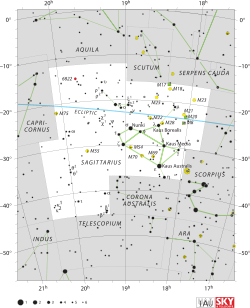Sigma Sagittarii

Location of σ Sagittarii (circled) | |
| Observation data Epoch J2000 Equinox J2000 | |
|---|---|
| Constellation | Sagittarius |
| Right ascension | 18h 55m 15.92650s[1][2] |
| Declination | –26° 17′ 48.2068″[1][2] |
| Apparent magnitude (V) | 2.05[3] |
| Characteristics | |
| Spectral type | B2.5 V[4] |
| U−B color index | –0.761[5] |
| B−V color index | –0.204[5] |
| Astrometry | |
| Radial velocity (Rv) | –11.2[3] km/s |
| Proper motion (μ) | RA: +15.14[1][2] mas/yr Dec.: –53.43[1][2] mas/yr |
| Parallax (π) | 14.32 ± 0.29[1][2] mas |
| Distance | 228 ± 5 ly (70 ± 1 pc) |
| Details | |
| Mass | 7.8 ± 0.2[6] M☉ |
| Radius | 4.5[7] R☉ |
| Luminosity | 3,300[8] L☉ |
| Temperature | 18,890[8] K |
| Rotational velocity (v sin i) | 165[9] km/s |
| Age | 31.4 ± 0.4[6] Myr |
| Other designations | |
Sigma Sagittarii (Sigma Sgr, σ Sagittarii, σ Sgr) is the second brightest star in the constellation Sagittarius. Its modern name Nunki is an Assyrian or Babylonian name recovered by archaeologists and made public by R. H. Allen.[10] Nunki has an apparent magnitude of +2.05,[3] making it readily visible to the naked eye. The distance to this star, determined using parallax measurements from the Hipparcos astrometry satellite,[11] yields an estimated value of 228 light-years (70 parsecs) from Earth.[1][2]
Nunki has a spectrum matching a stellar classification of B2.5 V,[4] which indicates this is a B-type main sequence star. The total luminosity of σ Sgr is 3300[12] times that of the Sun while it has a surface temperature of 18,890 K.[8] X-ray emission has been detected from this star, which has an estimated X-ray luminosity of 1.2 × 1028 erg s–1.[13] Sigma Sgr has a magnitude +9.5 optical companion located 5.2 arcminutes away.[citation needed]
Because it is close to the ecliptic, Nunki can be occulted by the Moon and very rarely by planets. The last occultation of Nunki by a planet took place on November 17, 1981, when it was occulted by Venus. Furthermore, Nunki is the brightest star that can be principally occulted by an exterior planet. However, only Mars can do this, and only rarely; the last time was on September 3, 423.[citation needed]
Name and etymology
- This star, together with :
- In Chinese, 斗 (Dǒu), meaning Dipper, refers to an asterism consisting of σ Sagittarii, φ Sagittarii, λ Sagittarii, μ Sagittarii, τ Sagittarii and ζ Sagittarii. Consequently, σ Sagittarii itself is known as 斗宿四 (Dǒu Sù sì, English: the Fourth Star of Dipper.)[17]
References
- ↑ 1.0 1.1 1.2 1.3 1.4 1.5 Perryman, M. A. C.; Lindegren, L.; Kovalevsky, J.; et al. (July 1997), "The Hipparcos Catalogue", Astronomy and Astrophysics 323: L49–L52, Bibcode:1997A&A...323L..49P
- ↑ 2.0 2.1 2.2 2.3 2.4 2.5 van Leeuwen, F. (November 2007). "Validation of the new Hipparcos reduction". Astronomy and Astrophysics 474 (2): 653–664. arXiv:0708.1752. Bibcode:2007A&A...474..653V. doi:10.1051/0004-6361:20078357.
- ↑ 3.0 3.1 3.2 Wielen, R. et al. (1999), Sixth Catalogue of Fundamental Stars (FK6). Part I. Basic fundamental stars with direct solutions (35), Astronomisches Rechen-Institut Heidelberg, Bibcode:1999VeARI..35....1W
- ↑ 4.0 4.1 Houk, Nancy (1979), Michigan catalogue of two-dimensional spectral types for the HD stars 3, Ann Arbor, Michigan: Dept. of Astronomy, University of Michigan, Bibcode:1982MSS...C03....0H
- ↑ 5.0 5.1 Gutierrez-Moreno, Adelina; Moreno, Hugo (June 1968), "A photometric investigation of the Scorpio-Centaurus association", Astrophysical Journal Supplement 15: 459, Bibcode:1968ApJS...15..459G, doi:10.1086/190168
- ↑ 6.0 6.1 Tetzlaff, N.; Neuhäuser, R.; Hohle, M. M. (January 2011), "A catalogue of young runaway Hipparcos stars within 3 kpc from the Sun", Monthly Notices of the Royal Astronomical Society 410 (1): 190–200, arXiv:1007.4883, Bibcode:2011MNRAS.410..190T, doi:10.1111/j.1365-2966.2010.17434.x
- ↑ Underhill, A. B. et al. (November 1979), "Effective temperatures, angular diameters, distances and linear radii for 160 O and B stars", Monthly Notices of the Royal Astronomical Society 189: 601–605, Bibcode:1979MNRAS.189..601U
- ↑ 8.0 8.1 8.2 Zorec, J. et al. (July 2009), "Fundamental parameters of B supergiants from the BCD system. I. Calibration of the (λ_1, D) parameters into Teff", Astronomy and Astrophysics 501 (1): 297–320, Bibcode:2009A&A...501..297Z, doi:10.1051/0004-6361/200811147
- ↑ Abt, Helmut A.; Levato, Hugo; Grosso, Monica (July 2002), "Rotational Velocities of B Stars", The Astrophysical Journal 573 (1): 359–365, Bibcode:2002ApJ...573..359A, doi:10.1086/340590
- ↑ Allen, Richard Hinckley, Star Names, their lore and meaning, p. 359
- ↑ Perryman, Michael (2010), The Making of History's Greatest Star Map, Heidelberg: Springer-Verlag, doi:10.1007/978-3-642-11602-5
- ↑ "NUNKI (Sigma Sagatarii)", Stars (University of Illinois), retrieved 2012-01-31
- ↑ Cassinelli, J. P. et al. (February 1994), "X-ray emission from near-main-sequence B stars", Astrophysical Journal, Part 1 421 (2): 705–717, Bibcode:1994ApJ...421..705C, doi:10.1086/173683
- ↑ "Sagittarius". deepsky.astroinfo.org. Retrieved 30 August 2008.
- ↑ skywatchers
- ↑ 16.0 16.1 Allen, R. H. (1963). Star Names: Their Lore and Meaning (Reprint ed.). New York: Dover Publications Inc. p. 355. ISBN 0-486-21079-0. Retrieved 2012-09-04.
- ↑ (Chinese) AEEA (Activities of Exhibition and Education in Astronomy) 天文教育資訊網 2006 年 5 月 11 日
| ||||||||||||||||||||||||||